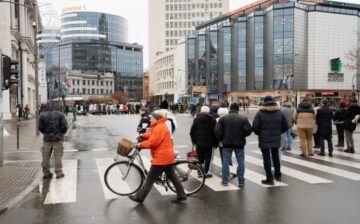As urban growth continues and population increases, neighborhoods will transform to accommodate new residents, businesses, and infrastructure. But not all communities are prepared for that development. A neighborhood that is truly ready for growth is one that has put in place strategic plans, robust infrastructure, and a vision for what will be needed in the future. If the aim is to attract families, support commercial growth, or improve livability, certain elements will determine that which sets them up for long-term success.

Strategic Land Use and Clear Planning Vision
A community that is prepared for growth starts with smart land use planning. In what is developed by community leaders, planners, and engineering firms, they see how they may integrate residential, commercial, and public spaces for the best results. What the planners put into their zoning should be a reflection of the long-term community needs, which in turn will support dense housing, retail that does well into the future, and recreational areas that serve residents.
Effective in its design, sustainability is a focus of good planning. Smart growth, which in turn supports mixed-use development, walkable streets, and environmentally responsible building practices. When these principles are put into play in development, they see neighborhoods that are better able to change and grow without losing their character.
-
Modern and Reliable Infrastructure
Infrastructure is the base upon which all dynamic communities are built. Designers put into design roads, utilities, drainage networks, and public transit, which must think beyond present needs to what will be required in the coming years. Also, without solid infrastructure, growth is a burden instead of a benefit.
Forward-thinking cities team up with experienced civil engineering colleagues at Pape-Dawson to evaluate present systems and put forth improved solutions. In quality engineering, they see to it that neighborhoods grow to support larger populations, heavier traffic, and state-of-the-art utilities; at the same time, they minimize that which disrupts. From restructured water systems to weather-resistant stormwater networks, modern infrastructure is a key element in a neighborhood’s preparation for growth.
-
Economic Momentum and Community Investment
Neighborhoods that are at the cusp of growth present signs of economic activity. They see local businesses growing and new development projects breaking ground, and there is a large interest from investors. Property values may go up slowly, which is a sign of stability and demand.
Public and private investment play equal roles. The government does this through tax breaks, renovation of roadways, or development of public facilities, which are some of the initiatives that do well in stimulating growth. Also, private players who put in structures like housing, retail, or mixed-use projects greatly contribute to a thriving community environment. When stakeholders put aside their differences for a common goal, the growth they see is not only achieved but is also very sustainable.
-
Strong Transportation Networks
Transportation is a key indicator of whether a neighborhood is ready to grow. They see this play out in the presence of major highways, public transit, pedestrian paths, or bike ways. What a connected area does is put it on the map for commutes, which in turn supports local businesses and also reduces traffic congestion.
Neighborhoods with large-scale transit projects, which include extended bus services, tuned traffic light systems, and designed roadways, also see greater success in terms of new residential and commercial growth. Also, accessible transport options improve the quality of life by which all residents may better access their community.
-
Available and Developable Land
Another key element to community growth is what land is available for development. Planners look at issues like topography, soil stability, environmental impact, and present land use regulations. What is available in terms of developable land allows for responsible expansion, which in turn sees new development that is a good fit with the present character of the area.
This is where expertise in land development nashville becomes highly valuable. They see that which is of a specialized nature related to the region’s regulations, environmental issues, and growth trends is very important. As communities turn to better-informed development strategies, the growth they see is not only smoother but also more efficient and sustainable.
-
Community Services and Quality-of-Life Features
Beyond which there are no roads or large structures, a neighborhood that is set for growth includes the everyday elements that residents value. They see in strong community assets—schools, health care facilities, parks, and public safety—the primary players that support population increase.
High-quality neighborhoods incorporate:
- Well-maintained parks and green spaces
- Modern schools and educational programs
- Accessible healthcare services
- Safe, walkable streets
- Spaces for recreation and social connection
These features, which in turn make the community very appealing to families, young professionals, and retirees. They see quality of life improvements, which in turn grow the community in a very meaningful way.
-
Sustainable and Environmentally Conscious Development
Environmental integrity is at the core of what they see in community growth today. Friendly practices like green infrastructure, energy-efficient building standards, and conservation-based design are being seen to play out. Sustainable development they seen as that which reduces long-term costs, reduces natural resources, and at the same time ensures that there are livable communities for future generations.
Organizations at the forefront of environmental responsibility play a key role in assessing flood risks, water quality issues, and ecosystem preservation. They also report on how to see neighborhoods through to better and more sustainable growth.
-
Supportive Community Engagement
Successful development is a result of community input. When residents, local businesses, and civic organizations get into the planning mix, they help to create projects that put the neighborhood’s values out. Community input builds trust, reduces conflict, and lets them see projects that benefit present and future residents.
Public forums, research studies, work groups, and open lines of communication are a part of what planners do. Neighborhoods that put effort into input from their residents see improved flow during growth.
We hope you found this blog post on What Makes a Neighborhood Ready for Growth, useful. Be sure to check out our post on Meeting People in Your Neighborhood for more great tips!
Have Experience in the Moving Industry? Want an Additional Income Stream? Work With All Around Moving!
All Around Moving’s Work With Us program provides experienced moving consultants with the opportunity to run their own Relocation Consultant business from anywhere in the USA. There are no recurring expenses, except for purchasing your own leads. We share profits 50%-50% with you from all jobs you booked with us. Click here to learn more.
We’re now accepting guest articles on our moving blog. Real estate agencies and brokers are encouraged to share strategies for selling residential real estate or leasing commercial properties.





